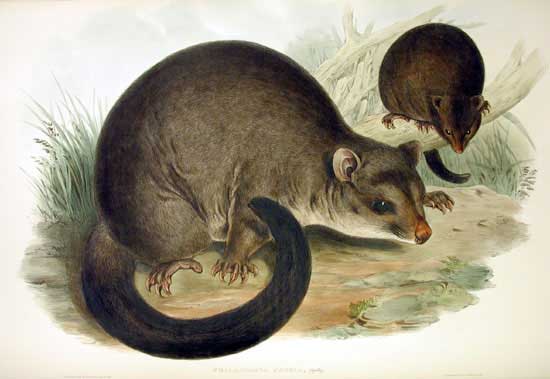|
| Query: marsupial | Result: 191st of 223 | |
Mountain Pygmy Possum (Burramys parvus) - Wiki
| Subject: | Mountain Pygmy Possum (Burramys parvus) - Wiki
| |

| Resolution: 550x379
File Size: 21937 Bytes
Upload Date: 2007:09:02 21:27:38
|
Mountain Pygmy Possum
From Wikipedia, the free encyclopedia
[Photo] Mountain Pygmy Possum, Burramys parvus. Author: john Gould
The Mountain Pygmy Possum (Burramys parvus) is a small, mouse-sized (weighs 45 g) nocturnal marsupial of Australia found in dense alpine rock screes and boulder fields, mainly southern Victoria and around Mount Kosciuszko in Kosciuszko National Park in New South Wales. It is approximately 11 cm long; although its prehensile tail is longer than the head and body at almost 14 cm. The Mountain Pygmy Possum eats insects (such as the Bogong Moth), fleshy fruits, nuts, nectar and seeds. It is covered in a thick coat of fine grey fur except for its stomagh which is cream coloured but the long tail is hairless. On the underside of its body it has a pouch containing four teats. This possum is somewhat singular, being the only extant species in the Burramys genus.[2]
The Mountain Pygmy Possum was first described as a Pleistocene fossil by Robert Broom in 1896. It was thought to be extinct until 1966, when a living specimen was discovered in a ski-hut on Mount Hotham.[3]
As of 1992, there were two geographically isolated populations, Mount Bogong - Mount Higginbotham/Mount Hotham (Victoria) and Kosciuszko NP (New South Wales). For most of the year, males and females live apart from each other. The females live on the better part of the rocky slopes, while the males live on the margins, usually lower on the mountain. In order to breed the males migrate to the females habitat. However, on Mount Higginbotham, the males had to cross a road at the peak of the ski season and their survival was put in danger. To solve the problem, a "Tunnel of Love" was constructed under the road and a road sign was put in place to warn drivers.
To further preserve the Mountain Pygmy Possum, a small proportion of the Perisher Blue Ski Resort, New South Wales, Australia, has been 'roped-off' to prevent resort guests (skiers and snowboarders) from disturbing the possums whilst they hibernate.
Taxonomy
†Burramys wakefieldi (Pledge, 1967)
†Burramys tridactylus (Turnbull, Rich & Lundelius, 1987)
†Burramys brutyi (Brammall & Archer, 1997)
Burramys parvus (Broom, 1895)
† = means an extint species.
http://en.wikipedia.org/wiki/Mountain_Pygmy_Possum
| The text in this page is based on the copyrighted Wikipedia article shown in above URL. It is used under the GNU Free Documentation License. You may redistribute it, verbatim or modified, providing that you comply with the terms of the GFDL. |
|
Comments |
|---|
| | Guest |
|
| haha |
| | Guest |
|
| This image is not the Mountain Pygmy-possum, Burramys parvus, but the Mountain Brush-tail Possum, Trichosurus caninus, it is from Gould's mammals of Australia vol 1 Published in 1863. A live Burramys was not seen until the 1960s. The title on this image is the old name for T. caninus |
^o^
Animal Pictures Archive for smart phones
^o^
|
|
|